10 Mistakes You’re Making That Wreak Havoc on Your House in Winter, Experts Say
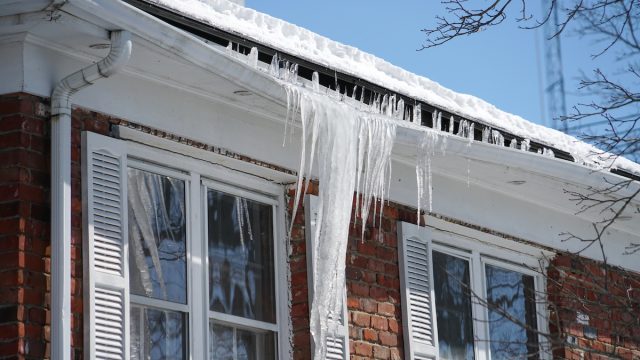
Winter’s destructive forces can damage our homes in ways we may not have even considered in warmer months. Ice, snow and frigid temperatures mean pipes can freeze, heating systems can fail, and clogged gutters can cause ice damage. If you know what to check before winter comes, you can avoid cold-weather calamities and enjoy your cozy haven while watching the snow pile up outside. Keep reading to hear from home maintenance experts about the biggest mistakes you’re making that wreak havoc on your house in winter.
READ THIS NEXT: 10 Mistakes You’re Making That Keep Your House Cold, Experts Say.
1
Not prepping your pipes.
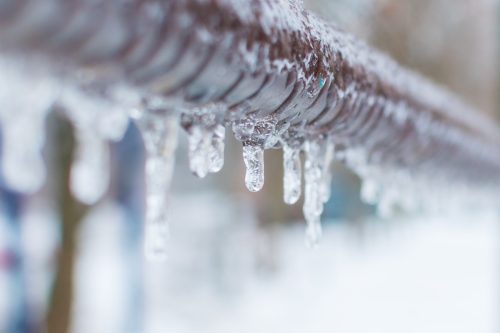
One of the most common winter hazards is frozen pipes. Although this can happen for several reasons, according to Bill Samuel, a Chicago-area residential real estate developer and general contractor, it often occurs “when homeowners forget to let faucets drip during freezing days or leave appliances unplugged over long periods.”
To prevent this, Samuel says “you should wrap exposed pipes in insulation and ensure that your attic space is adequately vented to avoid freezing.” And don’t forget to drain and turn off backyard faucets, and remove hoses and splitters from the spigot before the cold weather hits.
2
Not addressing water infiltration.
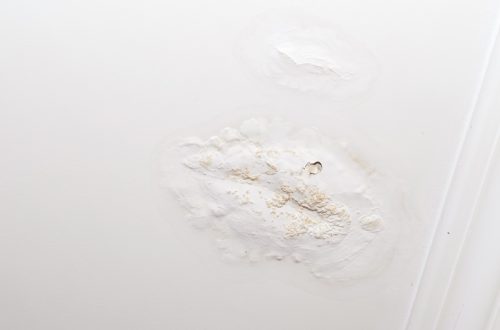
Don’t let leaks and drips persist when the temperature drops. “If water gets inside your walls or ceilings, it can cause structural damage,” says Matt Hagens, carpenter and founder/CEO of Obsessed Woodworking. “Make sure to catch any leaks early on so they don’t become too much of an issue later.”
And do realize that frozen pipes make leaks more likely. “Freezing and fluctuating low temperatures make leaks even more likely to occur, as freezing water within your plumbing places an insurmountable amount of stress on your pipes, causing cracks,” explains Winters Home Services.
Aside from the obvious dripping, ways to spot a leak include low water pressure, mold, and spikes in your water bill, according to Winters.
READ THIS NEXT: 5 Invasive Trees You Need to Remove From Your Yard Immediately.
3
Ignoring heating system maintenance.

A common pitfall that finds homeowners out in the cold is putting off heating-unit maintenance until the last minute—or after it’s too late.
“A failing or broken HVAC unit is one of the most common issues homeowners face in cold weather. If you don’t clean and inspect your furnace regularly, condensation can build up inside the unit, resulting in rust and corrosion over time,” shares Marty Ford, president of BulletpRoof Roof Systems. “Additionally, if your system isn’t properly vented, carbon monoxide and other toxic gases may leak into your home, putting you and your family at risk.” Checking the unit’s exhaust vent for clogs from snow and ice is a key step.
4
Not tending to gutters and downspouts.
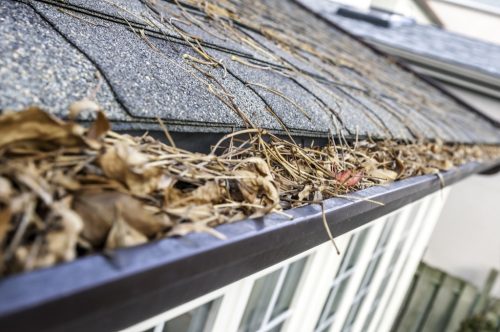
Water can freeze on surfaces like roofs and gutters when temperatures drop, causing damage. Regular cleaning can help prevent this from happening, but another common winter hazard is clogged or cracked gutters.
“Clogged gutters can cause water to back up underneath shingles or siding panels, leading to costly water damage,” notes Ford. “Broken drains can also lead to flooding and leaks, so it’s essential to make sure that they are checked and repaired regularly.”
But sometimes repair just doesn’t cut it. “Signs of wear like holes, cracks, and rust should not be overlooked. You may mend this if there are only a few, but consider replacing your gutter if there are too many,” adds Stephen Keighery, CEO and founder of Home Buyer Louisiana. “Another reason to replace your gutter is when nails and screws are missing, leaving your gutter not secured to the roofing. An unattached gutter can be a physical hazard to the house’s occupants.”
For more home advice delivered straight to your inbox, sign up for our daily newsletter.
5
Not inspecting your fireplace.
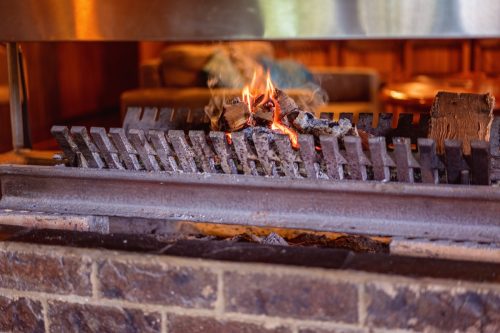
It’s important to have your fireplace inspected and cleaned regularly to prevent fires. Not checking the flue is another avoidable mistake.
“A build-up of soot or moisture inside a chimney may cause it to collapse (or worse), potentially damaging your home’s roof structure and other features along the way,” explains Hagens. “So make sure to check flues at least once a month during winter months.”
6
Not insulating exterior walls.
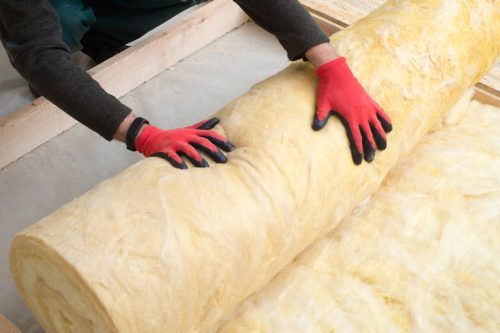
Without proper insulation, freezing temperatures can affect the structure of your home. Hagens warns that if exterior walls are improperly insulated, frigid temperatures can “cause metal framing members inside your home to expand and contract, leading to warping or even collapsing exterior walls.” To prevent this, “seal cracks around windowsills with caulk or silicone sealant; apply two coats if necessary,” advises Hagens.
READ THIS NEXT: The 5 Worst Things You’re Doing to Your Toilet, According to Plumbers.
7
Leaving electrical wires exposed.

When temperatures drop below freezing, water can wreak havoc in a number of ways. “Moisture from the ground can condense onto power lines and knock out electricity mid-storm,” says Hagens.
First, be sure any electrical wires outside the house are indeed intended for outdoor use. If you’re worried that a cable or power line is not safe, contact the corresponding utility company.
8
Not checking your smoke and carbon monoxide detectors.
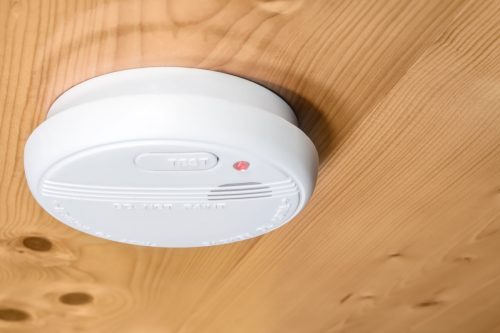
Smoke detectors should be checked monthly to make sure they’re working properly. This is especially important in winter when fires are more common.
Check carbon monoxide detectors, too, says Tim Wells, DIY expert and founder of Garage Transformed. “This will protect you from the damaging effects of carbon monoxide, such as lung damage, poisoning, or even death. In addition, carbon monoxide alarms can help alert you when there might be a problem with the ventilation system so that you can take steps to correct it before you start heating your home.”
READ THIS NEXT: It’s Rat Season—Here Are 8 Ways to Keep Them Out of Your House.
9
Forgetting the garage.
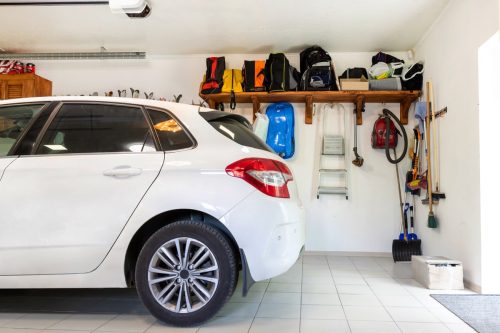
Your garage may be a great outside-the-house storage space, but it’s important to prepare it for the winter weather along with your home to avoid damage to your car or whatever items you’re storing there.
According to Stefan Kleinekoort, mechanic and founder/CEO of The Driver Advisor, “One of the best ways to protect your garage during winter is by sealing it up. This will help to keep the inside temperature consistent and avoid condensation buildup. Additionally, installing a vapor barrier can prevent moisture and mold from growing in the insulation, which could lead to structural damage. You can also invest in an indoor thermometer to be aware of the temperature inside your garage.”
10
Keeping woodpiles too close to the house.
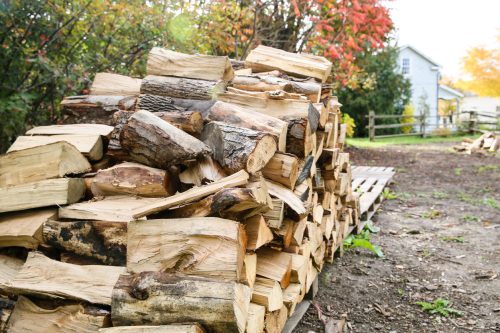
The convenience factor leads people to stack firewood in a woodpile close to the front or back door. But doing this can create a cozy home for bugs, snakes, and rodents who will then find their way into your house.
“Pests look for dark and warm places to crawl into during the winter. And your pile of wood is perfect for them,” explains Eyal Pasternak, Miami-based home remodeler and owner of Liberty House Buying Group. “You don’t want these pests to creep into your home next. So stack firewood away from your home; it should be piled above the ground.”